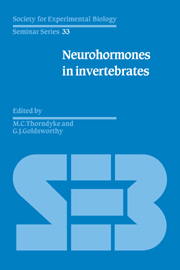Book contents
- Frontmatter
- Contents
- List of contributors
- Preface
- What is special about peptides as neuronal messengers?
- Part I Immunocytochemistry and Ultrastructure
- Part II Arthropod Neurohormones
- Part III Neurohormones in Coelenterates, Annelids and Protochordates
- Part IV Neurohormones in Molluscs
- Bioactive peptides in molluscs
- Actions and roles of the FMRFamide peptides in Helix
- Evolution of peptide hormones: an Aplysia CRF-like peptide
- Index
Actions and roles of the FMRFamide peptides in Helix
Published online by Cambridge University Press: 04 August 2010
- Frontmatter
- Contents
- List of contributors
- Preface
- What is special about peptides as neuronal messengers?
- Part I Immunocytochemistry and Ultrastructure
- Part II Arthropod Neurohormones
- Part III Neurohormones in Coelenterates, Annelids and Protochordates
- Part IV Neurohormones in Molluscs
- Bioactive peptides in molluscs
- Actions and roles of the FMRFamide peptides in Helix
- Evolution of peptide hormones: an Aplysia CRF-like peptide
- Index
Summary
The name ‘femerfamide’ (FMRFamide) has been given (Greenberg 1982) to the molluscan neuropeptide Phenylalanyl–methionyl–arginyl–phenylalanyl–amide (Price & Greenberg 1977). It is a mnemonic for the contained amino acids and was suggested to avoid prejudicing views about its natural role(s). (During the period of its discovery it was called Cardioexcitatory Neuropeptide because this was one notable action of the pep tide. See Price & Greenberg 1977.)
Price and Greenberg and their associates have shown that in molluscs there are several peptides chemically related to FMRFamide (see eg Price 1986): these are FLRFamide, pQDPFLRFamide, GDPFLRFamide and SDPFLRFamide. It is convenient to refer to these peptides with one name, as for instance are the opioid peptides, because like the opioid peptides, they appear to require a particular sequence of amino acids for activity and show a range of effects suggesting that they operate through several receptor types. Consequently we shall refer to the molluscan molecules as the femerfamide peptides.
With the opioid peptides the sequence Tyr–Gly–Gly–Phe (YGGF–) is required for full opioid activity, as with for example Met– and Leu–enkephalin, endorphin and dynorphin. This C–terminal sequence of amino acids has been called the message sequence by Charkin and Goldstein (1981). By contrast, in the femerfamide peptides the C–terminal sequence appears essential for activity, i.e. serves as the ‘message-sequence’: –Phe (or Tyr)–Met (or Leu)–Arg–Phe–NH2 (Price 1986).
- Type
- Chapter
- Information
- Neurohormones in Invertebrates , pp. 283 - 298Publisher: Cambridge University PressPrint publication year: 1988
- 4
- Cited by



